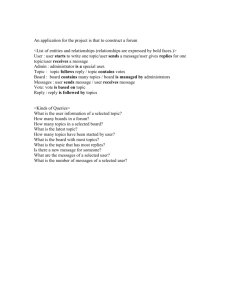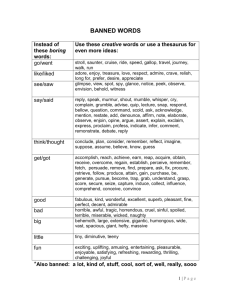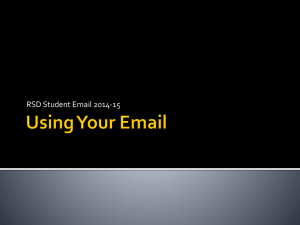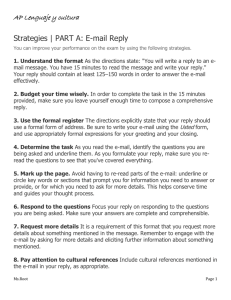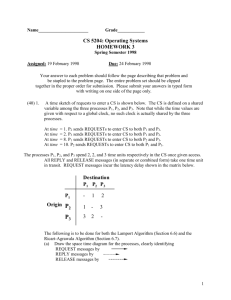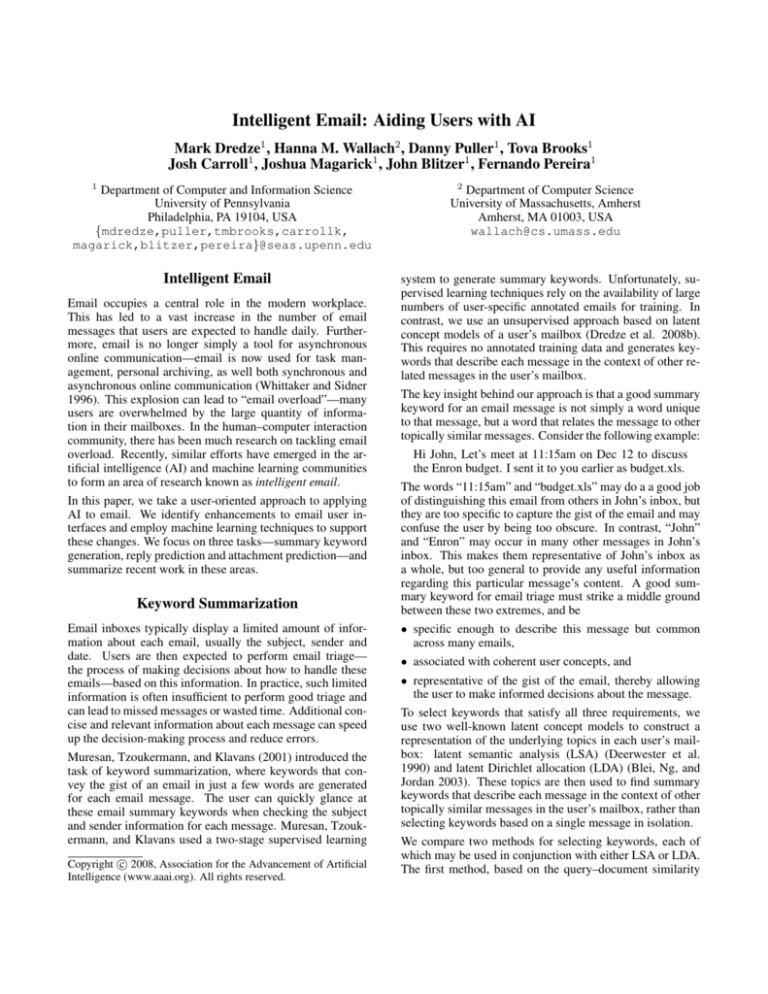
Intelligent Email: Aiding Users with AI
Mark Dredze1 , Hanna M. Wallach2 , Danny Puller1 , Tova Brooks1
Josh Carroll1 , Joshua Magarick1 , John Blitzer1 , Fernando Pereira1
1
Department of Computer and Information Science
University of Pennsylvania
Philadelphia, PA 19104, USA
{mdredze,puller,tmbrooks,carrollk,
magarick,blitzer,pereira}@seas.upenn.edu
Intelligent Email
Email occupies a central role in the modern workplace.
This has led to a vast increase in the number of email
messages that users are expected to handle daily. Furthermore, email is no longer simply a tool for asynchronous
online communication—email is now used for task management, personal archiving, as well both synchronous and
asynchronous online communication (Whittaker and Sidner
1996). This explosion can lead to “email overload”—many
users are overwhelmed by the large quantity of information in their mailboxes. In the human–computer interaction
community, there has been much research on tackling email
overload. Recently, similar efforts have emerged in the artificial intelligence (AI) and machine learning communities
to form an area of research known as intelligent email.
In this paper, we take a user-oriented approach to applying
AI to email. We identify enhancements to email user interfaces and employ machine learning techniques to support
these changes. We focus on three tasks—summary keyword
generation, reply prediction and attachment prediction—and
summarize recent work in these areas.
Keyword Summarization
Email inboxes typically display a limited amount of information about each email, usually the subject, sender and
date. Users are then expected to perform email triage—
the process of making decisions about how to handle these
emails—based on this information. In practice, such limited
information is often insufficient to perform good triage and
can lead to missed messages or wasted time. Additional concise and relevant information about each message can speed
up the decision-making process and reduce errors.
Muresan, Tzoukermann, and Klavans (2001) introduced the
task of keyword summarization, where keywords that convey the gist of an email in just a few words are generated
for each email message. The user can quickly glance at
these email summary keywords when checking the subject
and sender information for each message. Muresan, Tzoukermann, and Klavans used a two-stage supervised learning
c 2008, Association for the Advancement of Artificial
Copyright Intelligence (www.aaai.org). All rights reserved.
2
Department of Computer Science
University of Massachusetts, Amherst
Amherst, MA 01003, USA
wallach@cs.umass.edu
system to generate summary keywords. Unfortunately, supervised learning techniques rely on the availability of large
numbers of user-specific annotated emails for training. In
contrast, we use an unsupervised approach based on latent
concept models of a user’s mailbox (Dredze et al. 2008b).
This requires no annotated training data and generates keywords that describe each message in the context of other related messages in the user’s mailbox.
The key insight behind our approach is that a good summary
keyword for an email message is not simply a word unique
to that message, but a word that relates the message to other
topically similar messages. Consider the following example:
Hi John, Let’s meet at 11:15am on Dec 12 to discuss
the Enron budget. I sent it to you earlier as budget.xls.
The words “11:15am” and “budget.xls” may do a a good job
of distinguishing this email from others in John’s inbox, but
they are too specific to capture the gist of the email and may
confuse the user by being too obscure. In contrast, “John”
and “Enron” may occur in many other messages in John’s
inbox. This makes them representative of John’s inbox as
a whole, but too general to provide any useful information
regarding this particular message’s content. A good summary keyword for email triage must strike a middle ground
between these two extremes, and be
• specific enough to describe this message but common
across many emails,
• associated with coherent user concepts, and
• representative of the gist of the email, thereby allowing
the user to make informed decisions about the message.
To select keywords that satisfy all three requirements, we
use two well-known latent concept models to construct a
representation of the underlying topics in each user’s mailbox: latent semantic analysis (LSA) (Deerwester et al.
1990) and latent Dirichlet allocation (LDA) (Blei, Ng, and
Jordan 2003). These topics are then used to find summary
keywords that describe each message in the context of other
topically similar messages in the user’s mailbox, rather than
selecting keywords based on a single message in isolation.
We compare two methods for selecting keywords, each of
which may be used in conjunction with either LSA or LDA.
The first method, based on the query–document similarity
Figure 1: The accuracy averaged across 7 Enron users for
automated foldering using the message subject, the four
summary methods, and subjects and summaries combined.
Figure 2: Average precision across 7 Enron users for recipient prediction using the message subject, the four summary
methods, and subjects and summaries combined.
metric used in information retrieval, treats each candidate
keyword as a one-word query. The similarity between the
keyword and an email message is then computed via the latent topics. The second method is based on word association and involves choosing as keywords those words that
are most closely associated with the words that occur in the
message in question. Association is computed using the latent topics. A more detailed explanation of these methods
can be found in Dredze et al. (2008b).
better at summarizing messages for foldering and recipient
prediction tasks than sender-written subject lines. Combining summary keywords with email subject lines significantly
increases the amount of useful information available to the
user when making email triage decisions.
Results
The keyword generation methods described in the previous
section—LSA-doc, LDA-doc, LSA-word, LDA-word—were
evaluated by generating summaries for seven users selected
from the Enron data set (Klimt and Yang 2004). Keyword
quality was assessed using two proxy email prediction tasks:
automated foldering and recipient prediction. These tasks
simulate the sorts of decisions a user would make using
keywords and usually rely on the entire message body. In
all generation experiments, message bodies were replaced
with the generated summaries. Keywords generated using term frequency–inverse document frequency (TF-IDF),
along with complete message bodies, were used as lower
and upper baselines. In every experiment, our keyword generation methods improved over the TF-IDF baseline, and in
some cases performed better than using the entire message.
In addition to evaluating summary keywords as an approximation to message content, we also examined the extent to
which keywords provide additional information over message subject lines (figures 1 and 2). Every one of our generation methods produced keywords that, when combined
with subject lines, improved performance over using subject
lines alone. In some cases the keywords alone resulted in
better performance than the subject lines.
These results indicate that summary keywords generated using LSA- and LDA-based methods provide a good representation of email content. Furthermore, these keywords do
Reply Prediction
In a large mailbox, identifying messages that need a reply
can be time-consuming and error-prone. Reply management systems solve this problem by providing users with
tools to manage outstanding reply commitments (Dredze et
al. 2008a). We present a prototype interface that clearly indicates which messages require a reply and allows users to
manage messages, marking them as replied or needs reply,
as well as displaying all outstanding reply commitments. A
screen shot of the interface, as implemented in the Mozilla
Foundation’s Thunderbird mail client, is shown in figure 3.
Underlying the interface is a reply predictor system, which
automatically identifies messages that need a reply. This
task is a binary classification problem, where each email is
labeled by the system with either a positive label (needs reply) or a negative label (does not need reply).
The biggest challenge in creating a reply predictor is identifying the most appropriate way to represent email. Other
email classification tasks typically use bag-of-words representations of message bodies and subject lines, with quoted
text from previous messages removed, combined with features that indicate information such as message sender and
recipients (Segal and Kephart 1999; Cohen, Carvalho, and
Mitchell 2004; Carvalho and Cohen 2007). While these
features are clearly important for reply prediction too, additional features are also needed. Consider a user who sends
a message to Merrick and Tahlia with the subject, “Visiting
client schedule.” If Tahlia is only CCed on the message, then
it is likely that a reply is not expected from her. However,
Merrick, the primary recipient, is expected to reply. In other
words, the same message can receive two different classifi-
User
Jaeger
Jarvis
Merrick
Tahlia
Average
Recall
0.42
0.67
0.68
0.77
0.64
Precision
0.55
0.77
0.83
0.76
0.73
F1
0.47
0.71
0.74
0.77
0.67
Table 1: Reply prediction results for four email users, averaged over ten randomized trials.
Test
Jaeger
Jarvis
Merrick
Tahlia
Figure 3: The reply management interface in Thunderbird
has an additional column (4th from left; blue) in the bottom left pane that displays a reply arrow next to messages
that need a reply. Two buttons (red) above the message contents read: “Already replied,” which marks the reply as completed and “Does not need a reply,” which corrects the system. Messages that still need a reply are viewed by selecting
the “Outstanding Needs Reply” view (green).
cations, depending on the user’s role in the message.
To address this problem, we introduce user-specific relational features constructed from user profiles. Each user
profile includes the total number of sent and received messages for that user, the user’s address book, their supervisor
or boss (user-provided), as well as email address and domain. Features constructed using these profiles include I
appear in the CC list, I frequently reply to this user, and
sender is in address book. These sorts of relational features
have two advantages: Firstly, general behavior patterns can
be learned, such as overall tendencies towards address book
contacts. Secondly, a system trained on one user can be
adapted to a new user without any additional training data,
since the features capture general relationships and trends,
not specific email addresses or names. More information
about features can be found in Dredze et al. (2008a).
Evaluation
The reply predictor was evaluated on four users’ mailboxes
(2391 messages total). Messages were hand-labeled as either positive (needs reply) or negative (does not need reply).
Ten randomized runs were performed, each with an 80–20
training–test split. Results for each user are shown in table 1, measured using precision, recall and F1 score. The
precision scores are much higher than the recall scores, indicating that there are many messages that are difficult to
identify as needing a reply. As an upper-level baseline, interannotator agreement was computed for Tahlia and Jaeger’s
email, yielding an F1 score of 0.77. This is similar to the
Self
0.47
0.71
0.74
0.77
Recall
0.56
0.52
0.68
0.77
Precision
0.72
0.86
0.73
0.59
F1
0.63
0.65
0.71
0.67
∆
+0.16
-0.06
-0.03
-0.10
Table 2: A cross-user evaluation for four users averaged over
ten randomized runs. Each classifier is trained on three users
and tested on the fourth using relational and task specific
features. ∆ is the F1 difference between this experiment
and self, the full classifier trained on the user’s data only.
scores obtained using the reply predictor, demonstrating that
the system achieves performance similar to that of a human.
The reply predictor was also evaluated in a cross-user setting to determine its effectiveness on a new user with no
training data. The predictor was trained on three users while
the fourth was retained for testing. Baseline features, such
as bag-of-words features and address-specific features, were
not effective for cross-user evaluation, so they were omitted,
leaving only relational and task-specific features. Results are
shown in table 2, indicating that the system does well at predicting replies even when no user-specific data is available.
This is extremely useful for developing practical systems.
Attachment Prediction
Email attachments are a convenient way to transfer files and
an essential part of collaborative projects. Unfortunately, it
is easy for email senders to forget to attach a relevant document, creating workflow disruption, especially when the
sender is offline by the time the email is received.
Email interfaces could assist users by displaying a sidebar
of possible attachments, highlighting the “attach” icon, and
warning the user about missing attachments before sending
the message. We present an attachment prediction system
for detecting whether a message should contain an attachment (Dredze et al. 2008a). This binary classification task is
tackled using a similar approach to that of reply prediction.
Successful attachment prediction is dependent on both message content and other features, such as relational and taskspecific features. As with reply prediction, many relational
features can be generated from user profiles that include information such as the number of sent and received messages
for each user, and the percentage of messages that contained
an attachment. These profiles and resultant features capture
high-level patterns of attachment behavior. Additional task-
Split
User
Cross-User
System
Rule Based
Learning
Rule Based
Learning
Precision
0.8223
0.8301
0.8223
0.7981
Recall
0.4490
0.6706
0.4490
0.5618
F1
0.5808
0.7419†
0.5808
0.6594∗
Table 3: Attachment prediction results on Enron email for
the rule based and learning systems. Numbers are aggregate
results across ten-fold cross validation. ∗ and † indicate statistical significance at p = .01 and p = .001 respectively
against the baseline using McNemar’s test.
terfaces. Furthermore, artificial intelligence enables email
systems to better respond to and predict user behavior.
Acknowledgements
This work was supported in part by the Center for Intelligent Information Retrieval and in part by DoD contract
#HM1582-06-1-2013. Any opinions, findings and conclusions or recommendations expressed in this material are the
authors’ and do not necessarily reflect those of the sponsor.
References
specific features include the position of the word “attach” in
the email, the presence of other words in close proximity to
the word “attach,” and the length of the message body.
Evaluation
The attachment predictor was evaluated on 15,000 randomly
selected Enron sent emails from 144 users (7% have attachments). A rule-based system using the stem “attach” was
used as a baseline. Results (table 3) indicate that although
the rule-based system has high precision, it fails to find even
half of the emails with attachments. In contrast, our prediction system achieves slightly higher precision and much
higher recall, finding two-thirds of the attachment messages.
We also tested the system in a cross-user setting. Since
attachment prediction is content dependent, system performance is worse in the cross-user setting, but is still higher
than the rule-based baseline system.
Related Work
There are several systems that assist email users.
Neustaedter et al. (2005) created an interface that provides
social information about emails, allowing users to select
messages based on social relationships. Segal and Kephart
(1999) investigated systems for automated foldering that assist users with sorting and moving messages. Other work
by Wan and McKeown (2004) addressed email summarization to assist with processing large mailboxes, while thread
arcs can be used to position a new message in the context
of a conversation (Kerr 2003). Carvalho and Cohen (2007)
simplify message composition by suggesting possible recipients. Finally, many researchers have addressed the presentation of email, focusing on email as a tool for task management as well as communications (Kushmerick et al. 2006).
Conclusions
In this paper, we surveyed three ways to assist user email decisions using artificial intelligence. Some of this research is
already being used in intelligent email interfaces: the reply
and attachment predictors are part of IRIS (Cheyer, Park,
and Giuli 2005) and the attachment predictor is also being
integrated into a government email client. This work demonstrates that representations of email and user behavior play
a significant role in building effective intelligent email in-
Blei, D.; Ng, A.; and Jordan, M. 2003. Latent Dirichlet allocation.
Journal of Machine Learning Research 3:993–1022.
Carvalho, V. R., and Cohen, W. 2007. Recommending recipients
in the enron email corpus. Technical Report CMU-LTI-07-005,
Carnegie Mellon University, Language Technologies Institute.
Cheyer, A.; Park, J.; and Giuli, R. 2005. Iris: Integrate. relate. infer. share. In The Semantic Desktop Workshop at the International
Semantic Web Conference.
Cohen, W. W.; Carvalho, V. R.; and Mitchell, T. M. 2004. Learning to classify email into ”speech acts”. In Empirical Methods in
Natural Language Processing (EMNLP).
Deerwester, S.; Dumais, S. T.; Furnas, G. W.; Landauer, T. K.;
and Harshman, R. 1990. Indexing by latent semantic analysis. Journal of the American Society for Information Science
41(6):391–407.
Dredze, M.; Brooks, T.; Carroll, J.; Magarick, J.; Blitzer, J.; and
Pereira, F. 2008a. Intelligent email: Reply and attachment prediction. In Intellgent User Interfaces (IUI).
Dredze, M.; Wallach, H.; Puller, D.; and Pereira, F. 2008b. Generating summary keywords for emails using topics. In Intellgent
User Interfaces (IUI).
Kerr, B. 2003. Thread arcs: An email thread visualization. In
Symposium on Information Visualization (INFOVIS).
Klimt, B., and Yang, Y. 2004. The Enron corpus: A new dataset
for email classification research. In ECML.
Kushmerick, N.; Lau, T.; Dredze, M.; and Khoussainov, R. 2006.
Activity-centric email: A machine learning approach. In American National Conference on Artificial Intelligence (AAAI).
Muresan, S.; Tzoukermann, E.; and Klavans, J. L. 2001. Combining linguistic and machine learning techniques for email summarization. In Conference on Computational Natural Language
Learning (CONLL).
Neustaedter, C.; Brush, A. B.; Smith, M. A.; and Fisher, D. 2005.
The social network and relationship finder: Social sorting for
email triage. In Conference on Email and Anti-Spam (CEAS).
Segal, R., and Kephart, J. 1999. Mailcat: An intelligent assistant
for organizing e-mail. In Proceedings of the Third International
Conference on Autonomous Agents.
Wan, S., and McKeown, K. 2004. Generating overview summaries of ongoing email thread discussions. In Conference on
Computational Linguistics (COLING).
Whittaker, S., and Sidner, C. 1996. Email overload: exploring
personal information management of email. In Computer-Human
Interaction (CHI).


